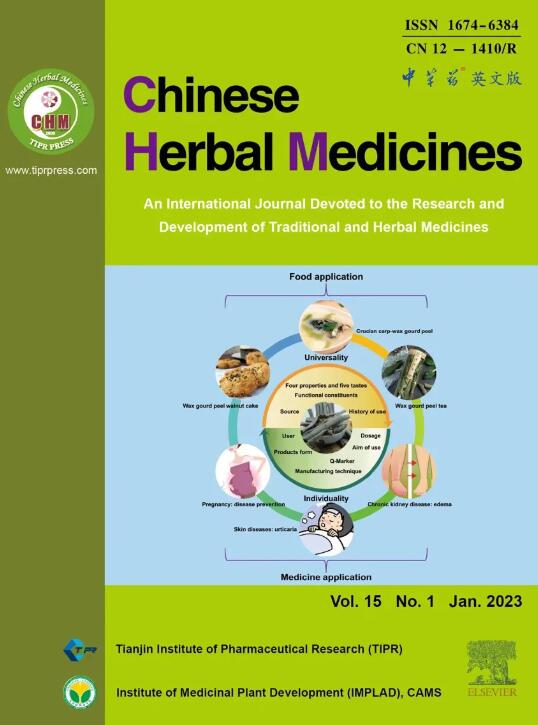通过下调胸苷酸合成酶揭示华蟾素抗肝癌作用的物质基础
IF 8.9
4区 医学
Q1 CHEMISTRY, MEDICINAL
引用次数: 0
摘要
目的肝细胞癌(HCC)是世界范围内死亡的主要原因。花蟾素是从蟾蜍干皮中提取的活性提取物。目前已广泛应用于临床治疗癌症,本研究旨在阐明花脓素诱导胸苷酸合成酶(TYMS)下调的物质基础。方法采用超高效液相色谱-质谱联用技术对花参素的主要生物活性成分进行鉴定。采用细胞计数试剂盒8 (CCK-8)法和克隆形成法检测肿瘤细胞的细胞活力。采用实时荧光定量RT-PCR和/或western blotting检测TYMS和γ-H2AX水平。采用小干扰RNA (Small interfering RNA, siRNA)转染,探讨抑制TYMS是否能增强花脓素对HCC细胞生长的抑制作用。结果在本研究中,首先鉴定出花参素中21种主要活性成分。CCK-8检测结果显示,花参素及其生物活性蟾毒二烯内酯(蟾毒苷、蟾毒苷、蟾毒苷、去乙酰蟾毒苷、arennobufagin、Telocinobufagin和Resibufogenin)对HepG2和SK-HEP-1细胞的增殖有明显的抑制作用,且呈剂量依赖性和时间依赖性。进一步的分子机制研究表明,花参素显著抑制胸腺苷酸合成酶(TYMS),该酶是DNA合成中胸腺苷酸的唯一来源。TYMS的抑制可导致肝癌细胞周期阻滞和DNA损伤。此外,我们发现花参素显著增加了γ-H2AX的表达,这表明存在DNA损伤。此外,我们证实用TYMS特异性小干扰RNA转染细胞可以增强花脓素对HCC细胞增殖的抑制作用。定量RT-PCR分析显示,花参素处理对TYMS的转录水平没有影响。此外,蛋白酶体抑制剂MG132可阻断花脉素诱导的TYMS抑制,蛋白合成抑制剂环己亚胺(cycloheximide, CHX)与花脉素合用可进一步抑制TYMS的蛋白水平,表明花脉素促进肝癌细胞中蛋白酶体依赖性的TYMS降解。更重要的是,花参素中具有生物活性的蟾毒素二烯内酯如蟾毒灵、蟾毒灵、蟾毒灵、去乙酰蟾毒素、阿仑蟾毒素、远凝蟾毒素、瑞蟾毒素等也能显著抑制TYMS的蛋白水平,揭示了花参素对TYMS抑制的物质基础。5-氟尿嘧啶(5-FU)是一种TYMS抑制剂,我们还对花参素与5-FU联合治疗的效果进行了评价。结果表明,花脉素与5-FU之间存在增效或拮抗作用。因此,在临床上应注意花喘素与5-FU合用的剂量。结论花参素通过蛋白酶体依赖性降解TYMS抑制人肝癌细胞生长并诱导DNA损伤,生物活性丁二烯内酯是花参素下调TYMS的物质基础。本文章由计算机程序翻译,如有差异,请以英文原文为准。
Material basis revelation of anti-hepatoma effect of Huachansu (Cinobufacini) through down-regulation of thymidylate synthase
Objective
Hepatocellular carcinoma (HCC) is a leading cause of mortality worldwide. Huachansu (Cinobufacini) is active extract isolated from the dry skin of Bufo Bufo gargarizans. It has now been widely used in clinical treatment of cancer, this study is to clarify the material basis of down-regulation of thymidylate synthase (TYMS) induced by Huachansu.
Methods
Our study utilized UPLC-MS/MS to identify major bioactive components from Huachansu. Cell Counting Kit 8 (CCK-8) assay and clone formation assay were used to examine the cell viability of tumor cells. TYMS and γ-H2AX level were detected by using quantitative real-time RT-PCR and/or western blotting. Small interfering RNA (siRNA) transfection was used to explore whether inhibition of TYMS could enhance the suppressive effect of Huachansu on cell growth of HCC cells.
Results
In our study, firstly, we identify 21 major bioactive components from Huachansu. CCK-8 assay results showed that Huachansu and its bioactive bufadienolides (Bufalin, Bufotalin, Cinobufotalin, Desacetylcinobufagin, Arenobufagin, Telocinobufagin, and Resibufogenin) significantly inhibited the proliferation of HepG2 and SK-HEP-1 cells in a dose- and time-dependent manner. Further molecular mechanistic investigation demonstrates that Huachansu significantly suppresses thymidylate synthase (TYMS), the enzyme which provides the sole de novo source of thymidylate for DNA synthesis. The inhibition of TYMS could lead to cell-cycle block and DNA damage of HCC cells. Furthermore, we identified that Huachansu markedly increased γ-H2AX expression, which indicated the presence of DNA damage. Moreover, we confirmed that transfection of cells with small interfering RNA specific to TYMS could increase the suppressive effects of Huachansu on the HCC cells proliferation. Quantitative RT-PCR analysis showed that Huachansu treatment had no effect on the transcription level of TYMS. Furthermore, proteasomal inhibitor MG132 could block TYMS inhibition induced by Huachansu, and concomitant administration of protein synthesis inhibitor cycloheximide (CHX) with Huachansu could further suppress the protein level of TYMS, indicating that Huachansu promotes proteasome-dependent degradation of TYMS in liver cancer cells. More importantly, the bioactive bufadienolides of Huachansu such as Bufalin, Bufotalin, Cinobufotalin, Desacetylcinobufagin, Arenobufagin, Telocinobufagin, and Resibufogenin could also significantly restrain the protein level of TYMS, revealing the material basis of inhibition of TYMS exposed to Huachansu. 5-Fluorouracil (5-FU) is a TYMS inhibitor, we also evaluate the effects of the combined treatment of Huachansu with 5-FU, the results show that interactions between Huachansu and 5-FU are synergistic or antagonistic. Thus, in clinical, attention should be paid to the dosage of Huachansu in combination with 5-FU.
Conclusion
Huachansu inhibits the growth and induces DNA damage of human HCC cells through proteasome-dependent degradation of TYMS, bioactive bufadienolides are the material basis of down-regulation of TYMS induced by Huachansu.
求助全文
通过发布文献求助,成功后即可免费获取论文全文。
去求助
来源期刊

Chinese Herbal Medicines
CHEMISTRY, MEDICINAL-
CiteScore
4.40
自引率
5.30%
发文量
629
审稿时长
10 weeks
期刊介绍:
Chinese Herbal Medicines is intended to disseminate the latest developments and research progress in traditional and herbal medical sciences to researchers, practitioners, academics and administrators worldwide in the field of traditional and herbal medicines. The journal's international coverage ensures that research and progress from all regions of the world are widely included.
CHM is a core journal of Chinese science and technology. The journal entered into the ESCI database in 2017, and then was included in PMC, Scopus and other important international search systems. In 2019, CHM was successfully selected for the “China Science and Technology Journal Excellence Action Plan” project, which has markedly improved its international influence and industry popularity. CHM obtained the first impact factor of 3.8 in Journal Citation Reports (JCR) in 2023.
 求助内容:
求助内容: 应助结果提醒方式:
应助结果提醒方式:


